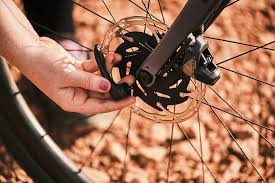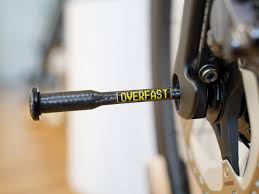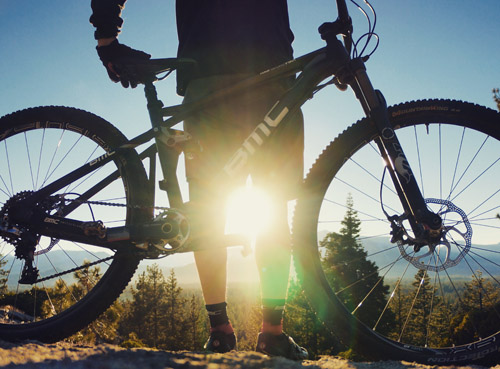
For many years now, there's been an ongoing battle between the thru axle and the quick release axle. At the moment, the mountain bicycle community has begun to greatly favor having a bike with a thru axle, as it has a few slight advantages over the standard quick release axle.
As an all-type bicycle rider, but more specifically a mountain biker, I always want to make sure that my bike has the best axles that'll hold my wheel through any terrain. To know which is best, I have to keep an open ear and an open mind on the advancements that every day brings.
In this article, we'll be taking a look at which bike axle reigns supreme and more importantly why.
Table of Contents
The quick release mechanism on qr axles works by using skewers to clamp the wheel to the bike´s frame (rear wheel) or fork (front wheel). These clamps use compression to hole the wheel in place.
Furthermore, the quick release axle rod slides through the wheel hub. This rod has a lever on one side and an adjusting nut or the other end.
Quick release axles are designed to work with U-shaped fork dropouts.
Finally, the axle has a quick release lever which can loosen or intensify the pressure that the clamps have on the wheel. Once the lever is in place, you can regulate the tension turning the nut on the other side of the axle.
If you plan to ride with road bikes or hybrid bikes, having a qr axle isn't a bad idea. They are very durable and the bike is very easy to work with.

Thru axles also go through the wheel hub. However, instead of having U-shaped fork dropouts, the fork has holes. On one side the fork has an integrated nut.
The thru axle system works by inserting the axle through the wheel hub. You´ll have to screw it into the integrated nut which is attached to the frame itself. By doing this, the thicker axle bolted directly into the frame of the bike will be incredibly resistant, making it really difficult for it to loosen. You can tighten the axle by placing a nut on the thru axle threads.
Just like quick release skewers, thru axles can loosen and tighten with a lever, however to adjust the tension on the axle, you´ll have to rotate.
The axle diameter is an important feature of the bike. The diameter describes the thickness of the axle and the thickness itself determines how resistant the axle is.
The axle diameter will vary from the front to the rear wheel.
Front Tire: 15mm
Rear Tire: 12mm
These are only standard sizes. Custom bikes could have very different designs and therefore the thickness of the diameter will change.
The thickness of a quick release skewer typically ranges from 5mm to 9mm. There skewers can vary in different sizes to adapt to the size of the wheel hub. However, the front wheel skewers should always be bigger than it´s rear counterpart.
Regardless of what we´ve seen, there are still ups and downs for both axles. Since they both work differently, let's take a look at their respective ups and downs.

In professional mountain biking, if you're on an uphill ride and decide to pedal while standing, you might notice how the bike might rock from side to side in your struggle to keep your balance. Riding like this can put pressure on the bike´s fork legs, causing them to slightly deform. This can cause the rim brakes or disc brakes to rub against the brake pads, which can slow you down in a race or damage your bike´s integrity.
Bike slippage refers to the phenomenon of the bike wheel coming loose. It is most commonly seen on bikes with qr skewers.
Brake drag happens when the calipers on the wheels fail to release the brake rotor. This makes the brakes generally less effective.
Starting with the basics, a bike axle is a metal rod that binds the wheel to the bike's fork in the front wheel and in the back it binds the back of the frame with the wheel.
Bike axles have to be able to spin around their own axis, while staying steady and holding the weight of the tire in place. They are traditionally made of steel or similar resistant metals.
The two most common types of bike axles are called quick release axles or quick release skewers. They are so named because they use skewers with a camming mechanism to hold the tire to the fork. They can also be easily removed. Thru axles are so named, because they tread through the tire and the circular dropout holes.
All things considered, thru axles hold the bike wheel tighter than in comparison to their rival.
There´s an important relation between the axle on your wheels and the brakes you have. We´ll take a look at some of the pros, cons and best matches that you can get for your bike.
Rim brakes are most commonly seen on road bikes and mountain bikes. These brakes theoretically work well with any type of axle. However, you'll most likely see these brakes paired up with qr axles.
When it comes to early downhill mountain biking, the preferred choice or brake-axle combination was a quick release axle with disc brakes. However, this quickly proved to be dangerous as the tension on the brake pads of the brake disc would significantly increase the chances of wheel slippage.
Additionally, the fork legs weren't moving in unison when the suspension compressed and also during braking. Many brakes began to fail altogether, causing cyclists to get a new partner for the disc brake on downhill courses.
As a result, on most mountain bikes you´ll see a pairing of thru axles with disc brakes now; a combination which is described to work great.
On disc brakes, thru axles normally create a lot of stiffness between the brake caliper and rotor. Since these axles are normally larger and have a stiffer connection to the frame, they don't allow for the rotor to move so much and therefore help to eliminate brake drag.
On quick release axles, there are some occasions where the brake rotor rub can create brake drag.

By now, you must have noticed that although both axles have quality, at present, thru axles are much better in most aspects.
As most bikes in this day and age still have a qr axle, you must be wondering if it's possible to make a switch.
It is possible, but it does require some work. Here are the things you could do.
Since qr axles are so slim, to fit a thru axle you´ll have two choices:
You could also try getting a thru bolt axle, which is a sort of axle that meets in the middle between qr axles and thru axles. It is placed on the bike exactly as a quick release skewer would but it is sturdier and thicker.
Although it may be difficult to find a match for your bike, this option is the cheapest and least complicated of all.
Another part you´ll have to mind is the wheel hub. To solve this issue, you´ll have to either buy an adapter or a new hub.
It would be fair to say that this isn't recommended, but it is totally possible.
Take note of the spacing on the wheel. This can either be 135mm spacing or 142 mm. Based on that, you can place an extra washer to fill the space if needed.
You should be okay with having a quick release wheel if you´re just planning to give your bike a light purpose, such as commuting or sightseeing. A quick release bike still has good braking force, braking performance and can go at great speeds. So it is still a very practical choice for the average biker.
Since thru axles are much thicker, they are ideal for mountain biking and resistance. If you´re thinking of doing something like this, getting a thru axle would be a good bet.
In 1927, an Italian bike racer by the name of Tullio Campagnolo invented the quick release axle. He was frustrated with the time and work it took to take out the wheel, so he decided to find a solution.
Eventually, after a few years of trial and error, Tulio created the first quick release axle, which gave him an edge over his competitors. Specifically, when it came to removing the wheel and replacing the tire with speed.
Quick release axles have been the main protagonist in the bike world for the last 80 years. However, overtime, bicycles have changed, and quick release axles have struggled to adapt to use cases.
After a few years of use, it was discovered that quick release axles couldn't handle the strain that comes with downhill mountain biking. The impact would make the skewers pop out, making it incredibly dangerous to ride mountain bikes.
The solution was thru axles. Instead of using u-shaped dropouts, bike engineers fashioned new dropouts with circular holes and made the axle out of a sturdier material. Since the thru axle goes from one side of the bike to the other, it is incredibly rare to see the wheel come loose.
With thru axles, the bike´s strength, stability and resistance in downhill bike riding improved tremendously. But most importantly, thru axles eliminated brake rub. Thus, the thru axle began to attract more and more bike riders.

If you want your bike to have a very slick look, you could try getting a thru axle without a cam lever. This axle is tightened with a wrench instead.
If you´re not convinced by these particular axles and you´re looking for something different, you can always get a bolt-on axle. This is ideal if you´re not looking to remove your wheel.
A thru axle bike is very reliable when you're on the slopes. If you´re planning on doing some intense extreme sport level riding, be sure to check you have the right axle for the job.
The thru axle system improves the bike´s braking force. It also provides a rigid connection to the frame and to the axle fork. The quick release system is all about quick switching, which is great. But the system isn't perfect. It can damage the axle forks and there's a chance that your axle could break or you get a bent axle if you´re doing some tough riding.
Thru axles are not compatible with some bike racks. In case you're thinking of taking your bike with you, be sure to check if your clamping mechanism is placed in the U-shaped dropouts. You can buy an adaptor to fit it into your car.
After taking a deep dive into the world of axles for bicycle wheels, let's start by saying that thru axles are indeed superior to quick release axles. However, just because they´re better doesn't mean you should rush to get them.
Quick release axles are still very efficient at what they do. They are practical and a great fit for the average biker. Despite this, the biggest reason to get thru axles is if you´re planning to do something extreme with your bike that requires the extra force.
In the end, the decision is yours. If you´re looking to buy a bike, you can go for one with a thru axle. This way you can enjoy all the benefits for no additional cost. If you have quick release axles, do the upgrade if you think it is worth it.
A final factor to consider would be where you are in the world and if you have access to such parts. Check that you have everything you need in case you have to move your bike. Now that you know everything about bike axles, you can make a wise choice.
